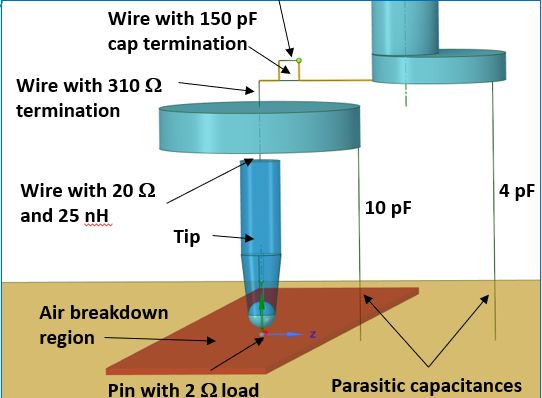Air Breakdown |
The simulation of arcing in air is part of the
EMA3D® feature of EMA3D Charge. As described in the EMA3D section of this manual, the software uses the 3D FDTD technique to track the propagation of EM fields and their interaction with a background media. Typically, the FDTD is used with a linear background, but as part of EMA3D Charge there is the possibility to simulate non-linear backgrounds. A non-linear background effectively "activates" the non-linear air chemistry module that simulates arc events.Nonlinear backgrounds are so termed because the three-species air chemistry formalism results in a conductivity that depends upon the strength of the applied electric field. The initial value of nonlinear backgrounds will be automatically set to vacuum electromagnetic parameter values.
There are two additional user-defined parameters associated with the nonlinear background. These parameters are the relative air density (ρair) and the absolute percent humidity (pw). The relative air density is related to the air density at sea level (1.22 kilograms/meter). A value of 1.0 implies a sea level density. The absolute percent humidity should not be confused with the relative humidity often provided by meteorological forecasts. The relative humidity usually expands the range from 12% in arid desert climates to 100% during periods of precipitation. However, the absolute humidity rarely exceeds 6%, even in some of the densest thunderheads. The allowable ranges for these variables are given below:

Assigning values outside of this range will result in an error message and program termination.
A word of caution concerning the relative air density is warranted. The algorithms used for the implementation of nonlinear backgrounds involve parameters that were derived from experiment. Setting the density to an extremely low value, perhaps less than 0.01, may be pushing this parameter into an untested realm.
Additional resources on the FDTD technique and the capabilities of EMA3D can be found in the EMA3D section of this manual. Technical material for the air-breakdown is available in the Technical Notes section of this manual.

To take advantage of the nonlinear air chemistry module, without overwhelming computing resources, a sub-region of the FDTD domain can be assigned a non-linear background. This capability allows the user to simulate the arc in a specific region of interest if the location of the arc is known.
If the location of the arc is not known, the whole FDTD domain should be assigned a non-linear background.
Alternatively, a faster arcing model (Quick Arc) exists in EMA3D Charge to identify an arcing region of interest or to efficiently simulate the current flow once the arc is generated.
The Quick-Arc feature automatically assigns an FDTD cell to be a prefect conductor if the electric field magnitude in that cell exceeds the user inputs. At the expense of a less accurate description of the arc formation, the simulation of the current flow (based on the model geometry and material properties) will be quick and accurate. As a result, the EM fields generated by the arcing current can be monitored across the model easily with the Field and Voltage probes.
The result of the quick arc is a reduction of the electric field magnitude to zero at the activation location. However, instantaneous reduction to zero results in the manifestation of excessive amounts of numerical noise. For this reason, the reduction is manifested over a time period. The effect is realized by slowly reducing the magnitude of the associated electric field to zero. The manner of reduction is provided by the equation below.

where: n is the number of time steps since the electric field achieve the arc initiation value.
EMA3D - © 2025 EMA, Inc. Unauthorized use, distribution, or duplication is prohibited.